Information/Write-up
As the driving force behind Chilliwack during their illustrious career, Bill Henderson knew that music was his calling early in life. The native of Vancouver was already a working musician while still in high school. He was a student at UBC in 1966 when he joined the group, The Collectors. While spending a whole lot of time in California they were signed to a record deal. After a pair of albums and a string of radio singles between ’67 and ’69, including “Lydia Purple” and “Early Morning,” which found them touring with the likes of The Doors and Jefferson Airplane, The Collectors were dead, Henderson was living in Vancouver – and from the ashes rose Chilliwack.
The band was rounded out by fellow ex-Collectors – drummer Ross Turney, Claire Lawrence on sax and keyboards and Glen Miller on bass. They cut their self-titled debut (also unofficially referred to as MASK because of the African head dress on the cover) in late ’70 on the independant Parrot Records. “Chain Train” was the first single, followed by “Rain O,” inspired by an Albert King show Henderson saw in San Francisco and a First Nations painting. Other noteable tracks included “Sundown” and “Everyday,” the next two singles to come off the record. “We recorded that record in 36 hours, recorded and mixed, the whole thing. We’d never done that before, or since,” Henderson reminisced.
But Miller dropped out and after picking up Robbie King and Rick Kilburn for various portions of their tours, the band was on the road non-stop, making stops throughout Canada, into the US, and the 1970 Expo in Japan. Once they came home, Miller soon dropped out, but they carried on – across Canada, to Japan, and all points in between.
The band released a self titled double album set a year later, featuring the instant radio classic “Lonesome Mary,” “Music For A Quiet Time,” “Travelling Music” and “Changing,” and they found themselves touring the continent again for the better part of a year in support of the album.
By the time ALL OVER YOU came out in ’72, Lawrence had left and Miller returned. The album contained some of Canadian rock’s most inventive and original music at the time, including “Groundhog”, which showcased Henderson’s incredible slide-guitar work. The song was actually a loose interpretation of a 200-years old British traditional contemporary song that had previously been covered by Buffy Saint Marie and the Every Brothers (their version was called “Muskrat”). Also on the record was the cool little ditty “Chickenshit Man”, while “Hot Winds” and “Rock n Roll Music” were straight out rockers. The album was also the first to feature Henderson’s brother Ed and sister Joan.
After a year on the road, RIDING HIGH hit the stores in the spring of ’74. Featuring newcomer Howard Froese as a second guitarist, the record was released on Terry Jacks‘ Goldfish Records label. Jacks also brought his experience in the business, (co-founder of The Poppy Family and his solo hit “Seasons In The Sun” that same year among others) to the studio and served as co-producer with Mike Flicker. By the end of the year Chilliwack practically owned the airwaves, with the title-track, “Come On Over” the absolute classic “Crazy Talk” and the raucous and rowdy “There’s Something I Like About That”.
Next up was ROCKERBOX, released the next year. The band switched to another independant label, Casino Records and producedJamie Bowers, Brian MacLeod, Bill Henderson, Glenn Miller, Ross Turney another masterfully-crafted album, highlighted by “If You Want My Love,” “When You Gonna Tell The Truth” and “Marianne.”
Another switch with labels saw the release of DREAMS DREAMS DREAMS on Mushroom Records in 1977. Mushroom’s office also played home to Doucette and Heart (when they were considered CanCon), among others. Backed by the mega hits “California Girl” and “Fly At Night”, Henderson and company had firmly established themselves as one of Canada’s top acts, touring the world in support of the album. Other hits included “Something Better”, “Baby Blue” and “Mary Lou And Me”.
1978 saw the debut of one of Canadian rock’s highest regarded collaberations. Henderson found himself looking for another guitarist to round out a fivesome and came upon Brian MacLeod. Although he was one of the country’s hottest unknowns, ‘Too Loud’ MacLeod as he would become known, had previously worked with Edward Bear and Pepper Tree. LIGHTS FROM THE VALLEY hit the stores in early ’78, met by rave reviews. MacLeod’s unbridled passion for his craft mixed with the raw energy that earned him his nickname were showcased in the hit “Arms Of Mary”, considered as one of the best Canadian songs that year, if not the decade. “Never Be The Same”, and “We Don’t Have To Fall In Love” also exemplified solid Canadian rock at its finest. A major North American tour ensued after Froese, Turney, and Miller all left. Along for the ride with Henderson and MacLeod were Jamie Bowers on guitars and keyboards, drummer Skip Layton and Ab Bryant on bass, who’d previously been with Prism.
BREAKDOWN IN PARADISE came out late in 1979 and again saw a re-vamped lineup. Bryant stayed on, ex of Prism – had replaced Miller on bass, Bucky Berger assumed the drummer’s role and John Roles was added on guitars. The record contained the hits “Road To Paradise” and the classic “Communication Breakdown”, while other noteable mentions included “So Strong” and “Let It All Begin”. But by the time the tour bus was warmed up, Berger was gone and was replaced by Rick Taylor behind the drumkit.
Again the band found themselves shopping for a label following the demise of MushroomRick Taylor, John Roles, Brian MacLeod, Bill Henderson, Ab Bryant Records in 1980. This led to Bryant and Brian MacLeod venturing off and starting The Headpins, initially as a sideline project. After signing with Solid Gold (home to The Headpins and Toronto, among others), a slight shift in gears was heard when Chilliwack’s next lp, WANNA BE A STAR came out in ’81. Roles and Taylor had left, and Henderson decided to keep the band a trio for the recording. “My Girl (Gone Gone Gone)” was gold practically on arrival at the radio stations. Other hits included the second single “I Believe,” “Living In Stereo” and “Don’t Wanna Live For A Living”.
Henderson took almost two years off while working on outside projects, when OPUS X was unleashed in ’82. With the smash hit “Whatcha Gonna Do (When I’m Gone),” the record was rounded out by a start to finish solid core of writing, including “Secret Information,” “Midnight,” and “Don’t It Make You Feel Right.” The effort earned MacLeod and Henderson a Juno for producer of the year, cementing Chilliwack as undeniably one of the country’s top draws. Henderson meanwhile was firmly establishing himself as one of rock’s most sought-after engineer/producers.
Following almost a full year’s worth of touring, Bryant & MacLeod left the band to pursue The Headpins full-time. Henderson again took some time to re-evaulte things and work on outside projects. In the meantime a compilation of their hits was on the shelves in ’83 with the release of SEGUE. The record also contained two new singles, “Don’t Stop” and “Gettin’ Better.”
LOOK IN LOOK OUT quickly went gold following its release the next summer, backed by the success of the single “Got You On My Mind” and a re-released versions of “Don’t Stop” and “Gettin’ Better.” With an entirely new lineup that consisted of Ashely Mulford, Mo Foster, Richard Gibbs and Simon Phillips, other great tracks included “Who’s Winning” and the soulful “Dream Of You”. Henderson’s outside commitments kept the band off the tour circuit until ’85. Along with a returning Claire Lawrence and John Roles, the group was rounded out by Robbie Gray on guitars, bassist Brian Newcombe and Jerry Adolphe on drums.
Chilliwack’s name wasn’t heard for nearly a decade, as Henderson was dabbling in an outside project of his own, UHF, with Shari Ulrich and Roy Forbes. Initially as little more than ‘something to do in their spare time’, the trio would get together to record their debut in 1990, and their follow-up in ’93, whose artistic tones instantly earned them favour with the critics.
Henderson continued on-again, off-again dates with various bandmates in between outside projects over the next decade, including a number of dates in the late ’90’s with UHF partner Roy Forbes. He also firmly entrenched himself as a producer extraordinaire, working with the likes of Junior Gone Wild, Toronto, Long John Baldry, The Nylons and The Irish Rovers, among others. He also became one of the people in your neighborhood during the late ’80s while working as a musical director for ‘Sesame Street’.
The appropriately titled Chilliwack double album ANTHOLOGY was released in ’94. THERE AND BACK – LIVE, Chilliwack’s first live album, was released in 2003. It featured the band he’d been touring with since ’98, Adolphe on drums, bassist Doug Edwards and Henderson’s brother Ed on guitars, and was the culmination of a couple of dozen shows. It nicely wrapped up Chilliwack’s career and electric versions of the band’s most essential numbers, as well as The Collectors’ “17th Summer.”
One song not included in the album was “Patent On The Wind,” a song Henderson wrote prior to the album’s release that received a tremendous response from the crowds, a song with a message he says needed written. “I want to write music about things that I think are important. And not all are political important, there’s also life important, love is important. I just want to create songs that I feel are saying something deep that I feel, that I believe. There are some things that need to be said, and they really desperately need to be said. There seems to be a lot of people afraid to say anything. And I don’t want to be one of those people afraid to say anything.”
With notes from Bill Henderson
Bill Henderson: guitars, piano, vocals
Claire Lawrence: flute, bass, organ, saxophone, vocals
Ross Turney: drums, organ on 'Night-Morning'
Arranged by Chilliwack
Produced by Chilliwack and Stephen Barncard
Engineered by Stephen Barncard
Recorded at Walley Heider Recording Studios, San Francisco, California, USA
Art direction by Roland Young
Album design by Chuck Beeson
Illustration by Sandra Darnley
Photography by Jack Wolfe
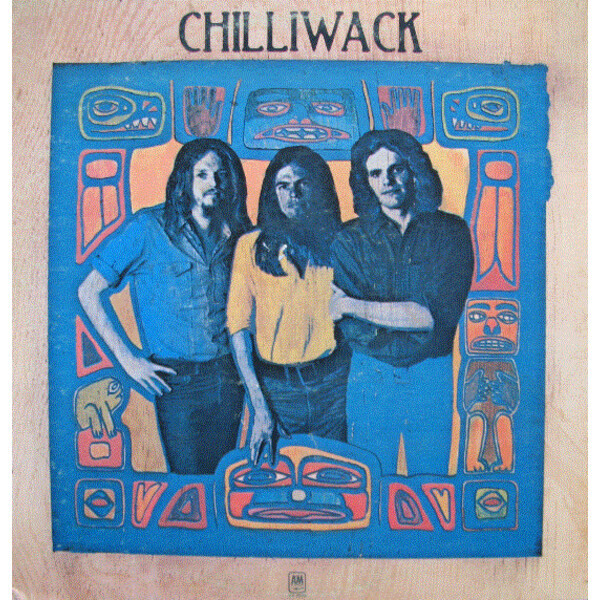
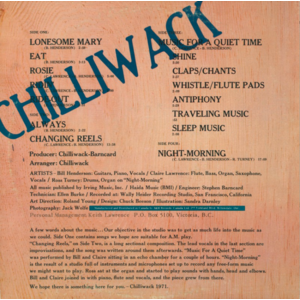
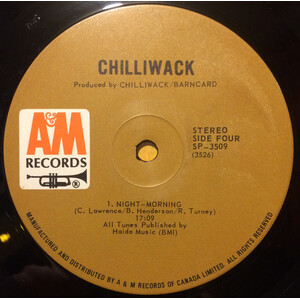
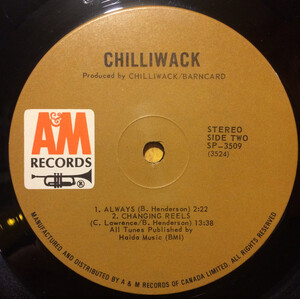
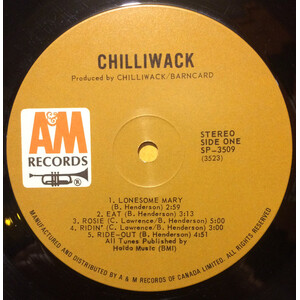
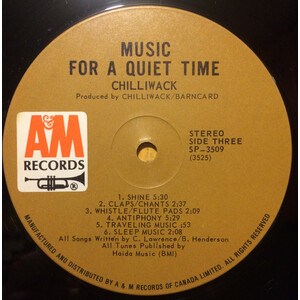
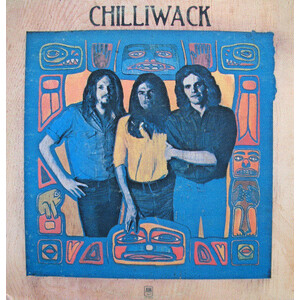
No Comments